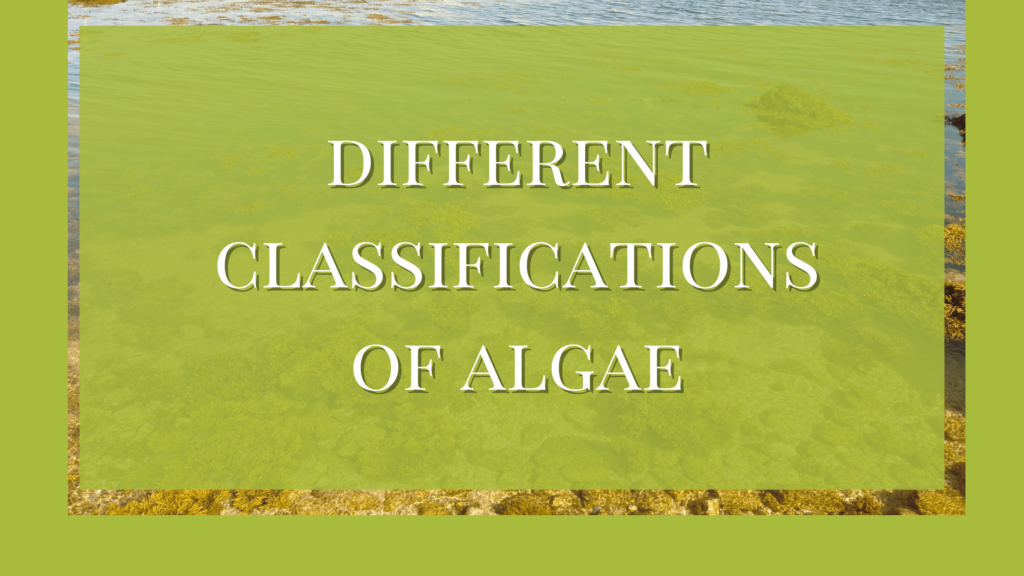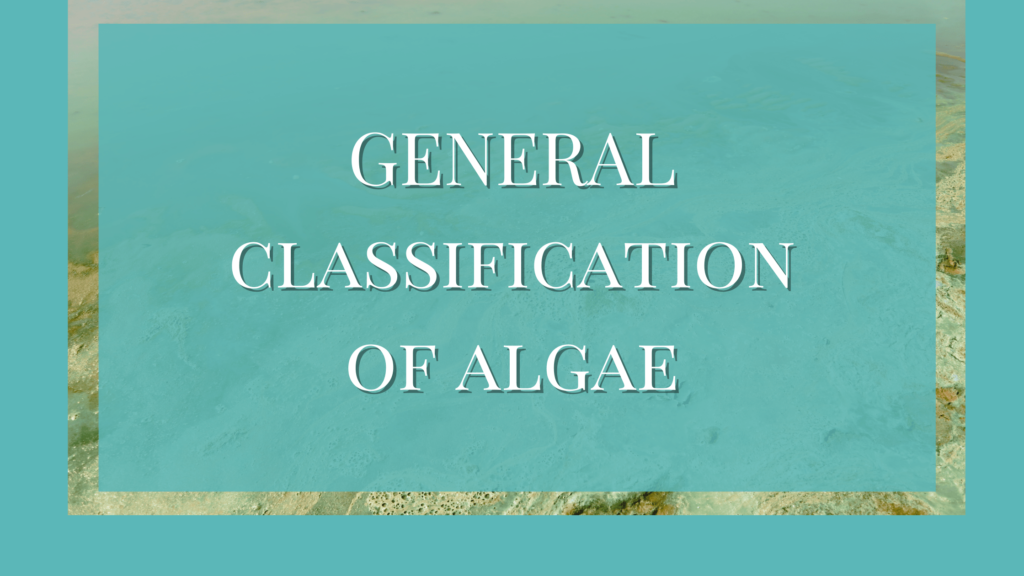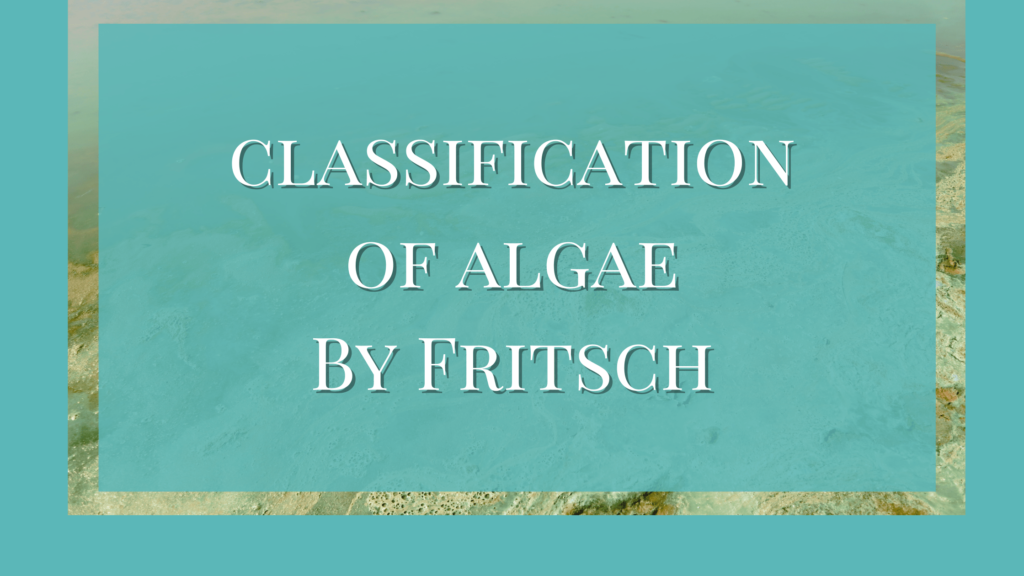Algae shows varied characteristics morphologically and physiologically. Many phycologists based their algae classification on their characteristics such as reserve food material, pigments, flagella, etc. However, there is no widely accepted algae classification.
Pigmentation in algae is one of the major criteria for the classification. Algae are popularly categorized into four groups based on their pigments.
- Cyanophyceae (blue-green algae)
- Chlorophyceae (green algae)
- Phaeophyceae (brown algae)
- Rhodophyceae (red algae)
Algae Classification Based on Pigments
| CLASS | TYPE | DOMINANT PIGMENT |
| Cyanophyceae | (blue-green algae) | c- phycocyanin |
| Chlorophyceae | (green algae) | chlorophyll a and b |
| Phaeophyceae | (brown algae) | (fucoxanthin) Xanthophylls |
| Rhodophyceae | (red algae) | (r-phycoerythrin) Phycobilin |
Linnaeus (1753) recognized about 14 genera in Algae out of which only 4 (Ulva, Conferva, Fucus, and Chara) were accepted as algae. He divided the entire plant kingdom into 25 classes of which one was algae. This algal group included the Hepaticae of Bryophytes.
A.L.De Juddeiu (1789) was the first to limit algae from the rest of the plant groups.
Unger (1838) separated thallophytes from the rest based on the thalloid form of the plant body. The thalophytes included algae, fungi, and lichens.
Harry (1836) distinguished three groups on the sub-class level.
- Chlorospermae included mainly freshwater green forms including BGA, red algae and green algae.
- Melanospermae for the marine brown algae
- Rhodospermae for the small red forms
Stizenberger (1860) classified Chlorospermae into two groups of Chlorophyceae and Myxophyceae (BGA). In 1874, Sachs renamed the latter into Cyanophyceae.
Robenhorst (1863) separated unicellular and colonial (Volvocales) forms from the sub-class Phytomastigina of class Mastigophora and Phylum Protozoa. He placed them under a class called Chlorophyllaceae.
The late eighteenth century saw remarkable works in the field of phycology by Sirodot (1884), Borned and Flahault (1887), Gommont (1893), Borzi (1874), Bohlia (1897- 1901), Luther (1899), etc. Luther (1899) studied the organization of flagella and recognized the types of isokontae and heterokontae.
J.G. Agardh (1842) divided algae into three groups Zoosporae (green and blue-green), fucoidae, and floridae. In 1898, he revised his proposals and recognized six orders such as,
- Diatomaceae
- Nostochineae
- Conforvoideae
- Ulvaceae
- Florideae
- Fucoideae
Allorge (1938) was the first to recognize Xanthophyceae.
In the early days, BGA and bacteria were grouped as Monera (Whittaker 1969) and placed in the Kingdom Protoctista. Stainer and Von Neil (1962) renamed monera as Schizophyta. In some treatments, monera was reorganized into Protista, Mycota, and Metaphyta. Fott (1959) referred to the same as Prokaryota. The chemolithic BGA, Beggiatoa acromaticum was suggested as a connecting link between the BGA and bacteria.
Modern Algae Classifications
One of the best algae classifications is that of Parker (1982) which represents the collective view of several leading phycologists. It recognizes a separation between prokaryotic forms, which lack membrane-bound organelles, and that include bacteria, the Cyanophyta. The recently proposed Prochlorophyta (Lewin 1976, 1977) and eukaryotic forms include algae and all other plants.
Bold and Wynne (1978) have recognized nine divisions in algae.
- Cyanophycophyta
- Chlorophycophyta
- Charophyta
- Euglenophycophyta
- Phaeophycophyta
- Chrysophycophyta
- Pyrrophycophyta
- Cryptophycophyta
- Rhodophycophyta
More recent algae classifications favor six divisions with 14 classes (Parker 1982).
| DIVISION | CLASS | |
| Prokaryota | Cyanophycota | |
| Prochlorophycota | ||
| Eukaryota | Rhodophycota | Rhodophyceae |
| Chromophycota | Chrysophyceae | |
| Prymnesiophyceae | ||
| Eustigmatophyceae | ||
| Bacillariophyceae | ||
| Dinophyceae | ||
| Phaeophyceae | ||
| Raphidophyceae | ||
| Cryptophyceae | ||
| Euglenophycota | Euglenophyceae | |
| Chlorophycota | Chlorophyceae | |
| Charophyceae | ||
| Prasinophyceae |
Pascher 1914-1921
Pasher erected the divisions Chrysophyta and Pyrrophyta in 1921. These divisions included Chrysophyceae, Bacillariophyceae, and Xanthphyceae. He separated Charophyceae from Chlorophyceae and elevated to the division Charophyta. Chlorophyta included two classes- Chlorophyceae and Conjugatae.
| DIVISION | CLASS |
| Chrysophyta | Chrysophyceae |
| Diatomeae | |
| Heterokontae | |
| Phaeophyta | Phaeophyceae |
| Pyrrophyta | Cryptophycea |
| Desmokontaee | |
| Dianophyceae | |
| Euglenophyta | Euglenophyceae |
| Chlorophyta | Chlorophyceae |
| Conjugatae | |
| Charophyta | Charcaceae |
| Rhodophyta | Bangineae |
| Floridinae | |
| Cyanophyta | Myxophyceae |
Classification Of Algae By Smith 1938
Smith’s classification is a modification of Pasher’s. He published an elaborated system of algae classification in 1955 which is based on the type of pigment, nature of reserve food, structure, and type of flagella.
| Division/Class | Class 1 | Class 2 | Class 3 |
| Chlorophyta | Chlorophyceae (grass green) | Charophyceae | |
| Euglenophyta | Euglenaceae | ||
| Pyrrophyta | Desmophyceae | Dinophyceae | |
| Chrysophyta | Chrysophyceae (Golden brown) | Xanthophyceae(Yellow-green) | Bacillariophyceae(Diatoms) |
| Phaeophyta(brown algae) | Isogenerateae | Heterogeneratae | Cyclosporae |
| Cyanophyta | Myxophyceae (Blue-green) | ||
| Rhodophyta | Rhodophyceae (Red algae) | ||
| Uncertain systematic position | Chloromonadaceae | Cryptophyceae |
Fritsch 1945
- The classification of algae by Fritsch consisted of 11 classes. He did not accept the separation of Charophyta from Chlorophyta.
- Elevation of Conjugales to Conjugatae was not favored.
- Elevation of Pyrrophyta and Chrysophyta to division level was not accepted.
- Cyanophyta is recognized as a division.
| CLASS | TYPE |
| Chlorophyceae | Isokontae, Grass-green |
| Xanthophyceae | Yellow-green |
| Chrysophyceae | Orange color |
| Bacillariophyceae | Golden brown |
| Cryptophyceae | Variable color |
| Dianophyceae | |
| Chloromonodinae | Bright green, food reserve fats |
| Eugleninae | |
| Phaeophyceae | |
| Rhodophyceae | |
| Myxophyceae |
Christensen 1962
- Christensen’s approach is interesting and different from that of all other algae classifications in certain aspects.
- Blue-green algae are kept as a separate group under the prokaryotes.
- The division Rhodophyta is separated from other algae since they do not have any flagellar stage.
- Chlorophyll b is taken as an important criterion for his classification. Those algae that lack chlorophyll b are placed under Chromophyta and those having this pigment are kept under Chlorophyta.
- Haptophyceae, a new class was erected. All marine flagellates are placed under this class. The members possess a third whip-like organ called haptonema. Unlike the members of Cryptophyceae, the other two flagella are equal in size and the haptonema is used to fix the organism to the substratum. Usually, these flagellates are grouped under Chrysophyceae because of their close resemblance to each other.
| DIVISION | CLASS | |
| Aconta | Cyanophyta | Cyanophyceae |
| Rhodophyta | Rhodophyceae | |
| Contophora | Chlorophyta | Chlorophyceae |
| Euglenophyceae | ||
| Prasinophyceae | ||
| Lokophyceae | ||
| Chromophyta | Phaeophyceae | |
| Dinophyceae | ||
| Cryptophyceae | ||
| Haptophyceae | ||
| Raphidophyceae | ||
| Chrysophyceae | ||
| Xanthophyceae | ||
| Bacillariophyceae |
Bourelly (1968) has retained this group Haptophyceae, as a sub-class Isochrysophycideae under the class Chrysophyceae. This sub-class consists of two orders,
- Isochrysidales- motile cells lack haptonema
- Premnisiales- motile cell possess haptonema
The second group is now being treated as a class under the name Premnesiophyceae (Hibberd, 1976)
Prescott 1969
Prescott followed Smith’s classification of algae, to a large extent.
| PHYLUM | CLASS |
| Chlorophyta | Chlorophyceae |
| Charophyceae | |
| Euglenophyta | Euglenophyceae |
| Chrysophyta | Chrysophyceae |
| Bacillariophyceae | |
| Heterokontae | |
| Pyrrophyta | Desmokontae |
| Dinokontae | |
| Phaeophyta | Isogeneratae |
| Heterogeneratae | |
| Cyclosporae | |
| Rhodophyta | Bangioideae |
| Florideae | |
| Cyanophyta | Coccogonae |
| Hormogonae | |
| Cryptophyta | Cryptophyceae |
| Chloromonophyta | Chloromonodophyceae |
Chapman and Chapman 1973
Chapman and Chapman included 11 divisions. Both Xanthophyceae and Chloromonads possess the same pigment composition, namely chlorophyll a and beta carotene.
Members of Prasinophyceae differ from Chlorophyceae by their flagellar structures (minute scales, lateral hairs, terminal tufts, and bipartite arrangement).
| ALGAE | DIVISION | CLASS |
| Prokaryotes | Cyanophyta | Cyanophyceae |
| Eukaryotes | Rhodophyta | Rhodophyceae |
| Chlorophyta | Chlorophyceae | |
| Prasinophyceae | ||
| Charophyceae | ||
| Euglenophyta | Euglenophyceae | |
| Chloromonodophyta | Chloromonodophyceae | |
| Xanthophyta | Xanthophyceae | |
| Bacillariophyta | Bacillariophyceae | |
| Chrysophyta | Chrysophyceae | |
| Phaeophyta | Phaeophyceae | |
| Pyrrophyta | Dinophyceae | |
| Desmophyceae | ||
| Cryptophyta | Cryptophyceae |
Algae Classification By Robert Edward Lee 2008
Group 1
- This is a group of prokaryotic algae such as Cyanophyta or blue-green algae for being the only prokaryotic algae.
- They have an outer plasma membrane surrounding the protoplasm with photosynthetic thylakoids, 70S ribosomes, and DNA fibrils.
- There is no separate membrane for the nuclear part.
- Chlorophyll a is the prominent pigment that produces oxygen by photosynthesis.
Group 2: This group consists of natural algae with double membranous plastids. They include Glaucophyta, Rhodophyta, and Chlorophyta.
Group 3: Members of Euglenophyta and Dinophyta have a single membraned chloroplast endoplasmic reticulum.
Group 4: Algae with double membrane chloroplast endoplasmic reticulum. The inner membrane of chloroplast ER envelops the chloroplast envelope. The other membrane of chloroplast ER is continuous with the outer layer of the nuclear envelope and has ribosomes on its outer surface. This group includes Cryptophyta, Prymnesiophyta (Prymnesiophyceae), and Heterokontophyta.
Here, Heterokontophyta includes families such as Bacillariophyceae, Chrysophyceae, Dictyophyceae, Eustigmatophyceae, Pelagophyceae, Phaeophyceae, Raphidophyceae, Synurophyceae, and Xanthophyceae
Conclusion
Thus, algae classification has come a long way over the past century. the currently accepted algae classification includes the classes, Bacillariophyceae, Chlorophyceae, Chloromonodineae, Cryptophyceae, Chrysophyceae, Dinophyceae, Euglinineae, Myxophyceae (Cyanophyceae), Phaeophyceae, Rhodophyceae and Xanthophyceae.
This is much closer to the classification of algae by Pascher. However, further divisions into subclasses and beyond, make them world apart. Yet, characteristics of algae such as their cytological and chemical nature, that form the base of the classification remain the same.
References
- Christensen, T. (1964, January 1). The Gross Classification of Algae. Springer eBooks. https://doi.org/10.1007/978-1-4684-1719-7_3
- Baweja, Pooja & Sahoo, Dinabandhu. (2015). Classification of Algae. 10.1007/978-94-017-7321-8_2.




